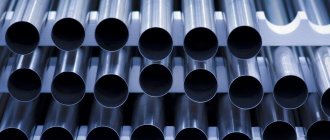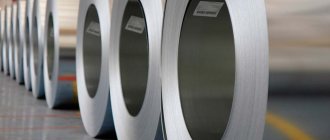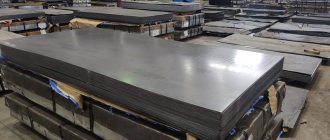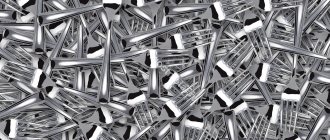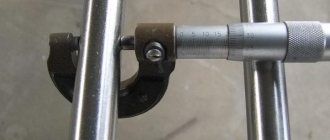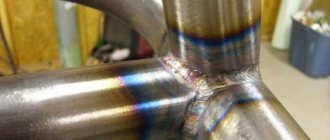Home / Welding technique
Back
Reading time: 3 min
0
1821
Silver is one of the popular types of metal of the 21st century. Both on an industrial scale and at home.
Steelworkers have enough work, which is why this type of welding is in great demand today. The work of good workers is appreciated and well paid.
But to ensure high-quality work, you need to think about the materials you will be dealing with. Our article will discuss the characteristics of steel 12x18n10t.
We'll tell you what materials you should work with, what electrodes you'll need, and how to make sure the connection is strong. This is easy to achieve by following our simple tips.
- Brand characteristics
- Electrodes
- Mineral
- Work organization
- Technology
- Let's sum it up
Brand characteristics
Before we talk about welding work, it is necessary to pay attention to what this steel is.
The main point is that stainless steel 12x18n10t is often subject to corrosion. This happens despite the fact that the material is quite resistant to it.
This outcome of events is possible when you pierce metal in a stove. In other words, for corrosion to occur, a temperature of 500 degrees is required.
To prevent this from happening, many manufacturers mix alloying components into stainless steel. In the case of our brand, this is titanium.
You can recognize this by noticing the letter “T” that is located at the end of the marking. Before starting the welding process, it is important to carefully study the components of the alloy. This is necessary to ensure that all stages go smoothly.
Where is steel 12x18n10t used?
If we talk about the use of 12x18n10t steel, then we can list it here for quite a long time, because as mentioned earlier, the properties really allow you to use this option in almost any conditions. The high resistance to aggressive environments allows this type of steel to be used in the chemical industry, in particular for the production of vessels that operate under high pressure.
Among other things, pipelines are often made from this type of steel, which in turn are used to transport solutions of phosphoric, acetic, nitric and other acids; this metal is also used for equipment working with radiation. The food, oil, gas and energy industries may require this type of steel everywhere.
A distinctive feature of this type of steel is that it can be used in cryogenic installations, where the temperature drops to -296 degrees.
Sheets made from this type of steel are used for construction work, in the production of finishing materials, and so on.
Electrodes
Typically, in the manufacture of this material, components consisting of alloyed metal are used. It has a base coat.
The composition of the latter includes alloying components. Due to the similarity of the structure of stainless steel and electrodes, the exit seams will be durable and will last for many years. This is not the main advantage of the material with which you will have to work.
If you correctly define the electrodes, you can both supplement and transform chemical elements. It is important to remember that during melting the electrode is connected to the base metal in a special bath.
This allows you to change the characteristics of the welding joint.
The welding process can be achieved by following simple methods. First of all, we advise you to pay attention to the components of the electrodes.
Types of wire for stainless steel 12Х18Н10Т
This brand is available in several main varieties. According to production accuracy, products of normal and high precision are distinguished. Based on the plastic properties, the first and second classes are distinguished. According to the type of processing, there can be oxidized and light-colored welding wire. According to the manufacturing method, hot-rolled and cold-rolled are distinguished.
Type of wire for welding stainless steel 12Х18Н10Т
Mineral
Speaking of advantages, we note their good work with stainless steel 12x18n10t. In 8 cases out of 10, secondary components are used. Use them simultaneously with wires made from high-alloy wires.
And here the welding flux type ANF-5 will come to the rescue. It is capable of isolating the bath from oxidative processes, and also provides alloying of structures.
Another advantage of this flux is that it prevents the appearance of pores in the joints. Instead of a secondary base, an oxide base is used, which is no worse than the first.
Electrodes for stainless steel with direct current
One of the most popular brands is TsL-11. These electrodes have a basic coating and can be used for welding steels with increased strength. They are also successfully used for welding products made of chromium-nickel steel. The advantage of these electrodes is that the seam created with their help has strength and ductility.
For connections in products that will be operated at elevated temperatures, OZL-8 brand electrodes should be selected. The range of sizes of such electrodes is 3.0; 4.0; 5.0 millimeters. NZh-13 electrodes are suitable for welding products used in the food industry.
The advantage is that a thin crust of slag is formed, which falls off on its own. Electrodes of the ZIO-8 brand, having a rutile-base coating, are used for heat-resistant steels. NII-48G electrodes are used to carry out work on structures that have important purposes. For products that will be used in an environment with phosphoric or sulfuric acid, the choice should be made of electrodes of the OZL-17U brand.
Work organization
After determining the advantages of the electrodes, you can select the welding mode. First of all, look at the amount of heat input.
This is the speed that current needs to pass from the arch to the metal. For stainless steel marked 12x18n10t this indicator should be low.
We recommend creating thin connections with a small cross-section. This is possible when working with welding wires whose diameters do not exceed 3 mm.
Do not forget that stainless steel has low electrical conductivity. To avoid unnecessary questions, it is worth reducing the electrode stickout by a couple of times compared to the indicator with a carbon design.
Features of welding stainless steel 12x18n10t
Steel 12Х18Н10Т is considered to be easily weldable. Characteristic
A special feature of welding this steel is the occurrence
intergranular corrosion. It develops in the thermal zone
influence at a temperature of 500-800C. When the metal remains in such
critical temperature range along austenite grain boundaries
chromium carbides fall out. All this can have dangerous consequences -
brittle destruction of the structure during operation.
To achieve steel durability, it is necessary to eliminate or weaken the effect
precipitation of carbides and stabilize the properties of steel in the welded area
seam
Welding methods
When welding austenitic stainless steel, one should take into account
the following differences between its physical properties and those of carbonaceous
rolled: specific electrical resistance is approximately six times
higher melting point approximately 100C lower thermal conductivity
is about one third of the corresponding figure
carbon rolled products. coefficient of thermal expansion along length
approximately 50% more In practice, welding can be done using
any welding methods: Manual arc welding usually with thickness
material more than 1.5 mm Tungsten arc welding in
inert gas (TIG) for welding thin sheets and pipes Arc welding
consumable electrode in inert gas / Welding in an active environment
gases (MIG/MAG) characterized by high performance pulsed
consumable electrode arc welding in inert gas, for sheets
0.8 mm thick short arc consumable electrode welding in
inert gas, for sheets less than 0.8-3.0 mm thick, arc welding with
jet transfer of metal, consumable electrode in an inert gas,
for sheets with a thickness of more than 3.0 mm. Plasma welding can be used
increasingly used for a wide range of thicknesses. Dugovaya
submerged arc welding for materials with a thickness of more than 10 mm. Welding
resistance spot and roller welding of thin sheets.
Post-processing of welds
A porous oxide layer is formed on the surface of the welded joint.
layer containing mainly chromium. This layer is largely
weakens the connection's resistance to corrosion. Chromium oxide layer in
the main material arises from steel, as a result of which under the oxide
the so-called layer is formed. with reduced chromium content. If
there is a need to ensure that the resistance of the welded joint to
corrosion was as high as that of the base material,
the oxide layer and the zone with reduced chromium content should be removed,
those. The welded joint must undergo subsequent processing.
Heat treatment
In this case, heat treatment means dissolution inside
steel structure (more than 1000 C), with the help of which they are smoothed
differences in filler materials that have arisen.
Mechanical post-processing methods
You should always remember that you are only allowed to use those
working accessories intended for processing stainless steel: grinding belts and wheels intended
for processing stainless steel brushes, stainless steel shot
made of stainless steel during shot blasting (Attention! With
sometimes it is not possible to use steel or glass shot or sand
process other materials, e.g. carbon steel)
Etching
Etching is the most effective method of subsequent
processing of welds. When done correctly, etching
allows you to eliminate both the harmful oxide layer and the zone with reduced
chromium content. Etching is done by immersion,
surface application or paste coating depending on
conditions. Most often, a mixing acid is used for etching: nitric
acid/hydrofluoric acid (hydrofluoric acid) in the following
proportions:
8 – 20% HNO3 (nitric acid) 0.5 – 5% HF (hydrofluoric acid)
acid) other components H2O (water)
The pickling time for austenitic stainless steel products depends on
acid concentration, temperature, scale thickness and rolled product grade
(so-called acid-resistant rolled products require a longer time
processing compared to stainless steel). Finishing the degree
roughness of the weld to the corresponding indicator of the main
sheet by grinding or polishing after etching even more
increases the structure's resistance to corrosion.
This is interesting: the properties of stainless steel
Technology
Now we will talk about the most interesting aspects of welding work on stainless steel marked 12x18n10t. When metalworking and using stainless steel, it is possible to use a semi-automatic welding method in the field of shielding gases.
Contact metalworking technology, welding with non-consumable components and metalworking with artificial electrodes are allowed.
When we talk about shielding gas, we use argon, a compound of argon with carbon dioxide or helium. As an example, we can talk about argon arc processing and non-consumable component welding.
Argon-arc welding using electrodes of different actions is popular with craftsmen with ten years of experience or more. To perform this procedure, it is worth setting up the reverse polarity.
Let's sum it up
Our article presents material about known methods of welding stainless steel marked 12x18n10t. Every year technology expands and progress moves forward.
One thing remains unchanged: for high-quality products and seams, you need to have extensive experience and adhere to all welding processes. The availability of professional welding equipment will also be important.
If you are just starting to understand the welding business, you do not need to worry. At first you will not be able to get a strong connection, this is quite normal. As you progress, you will improve your skills.
In a year or two you will be able to weld complex metal structures. Already have experience welding stainless steel marked 12x18n10t or other metals? Write to us about it in the comments. We wish you success!

